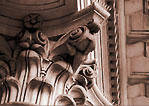“The Shock of the Other”—Vol.
1, Millennium: Tribal wisdom for the Modern World
Anthropologist: David Maybury-Lewis
OTHERING: a natural human trait: to separate us/them; me/you Peruvian Rainforest [a.k.a. jungle]
to seek out the Mashku Piro This group is little known. The first picture of a group of 3 women was taken in 1979.
CULTURAL SURVIVAL—an organization whose mission
is to try to help indigenous peoples worldwide to hold their own in the modern world. Maybury-Lewis is the director of it.
*A Primary question: Do we HAVE to
make other societies and people over in our own image? He is in Peru to try to help prevent a disaster from happening to the
Mashku Piro similar to the one that happened to another tribe, the Yaminowa, upon 1st first contact in 1984. At that time,
the Yaminowa were equally unknown to the Westernized world. When they were contacted by Westerners, many diseases, e.g. pneumonia
and measles, were passed to the Yaminowa. The diseases killed as many as half of the population.
*What does he mean by the “rape of innocence?” Sitting in
a saloon in the last village before the national park in Peru, Maybury-Lewis thinks about how people make other people, unfamiliar
people, into monsters. That is, something divorced from nature, outside of nature and horrible. He also thinks about what
the people he worked with over 30 years in Brazil, the Xavante, said of the ruining of the rainforests: it ruins the Web of
Life, it is the destruction of the tribal world by the industrialized world.
ONCE THE CREW ARRIVED, there were many problems. One of the main ones was with IDACEP,
Peruvian Indian Organization, who would not grant permission for the crew, or Maybury-Lewis, to go up the river they are generally
visible on to take pictures. This was mainly due to the fact that no one else had ever asked permission of IDACEP before.
Also, the agency didn’t want M-L and the crew to “chase a lost tribe up a river.” Maybury-Lewis’s
primary motive for doing the film was to show how Anthropology could be accomplished differently than the perceived norm.
He decided that they would go on but up another river, and to shoot photos only with a long-range lens. They would also make
no 1st contact. The guides for the crew were Macheguenga, another larger tribal group in Peru. The Macheguenga think of the
Mashku Piro like Westerners treat the Macheguenga—and, by extension, all other non-Westerners—as uncivilized,
like children, like “savages,” like some exotic zoo animal.
*UNRAVEL THE MYSTERY—anthropologists go to the field and study to meet the other. However,
Maybury-Lewis honored the agreement to stay away from the Mashku Piro. He chose to leave the mystery intact and leave the
Mashku Piro until THEY are ready to meet.

